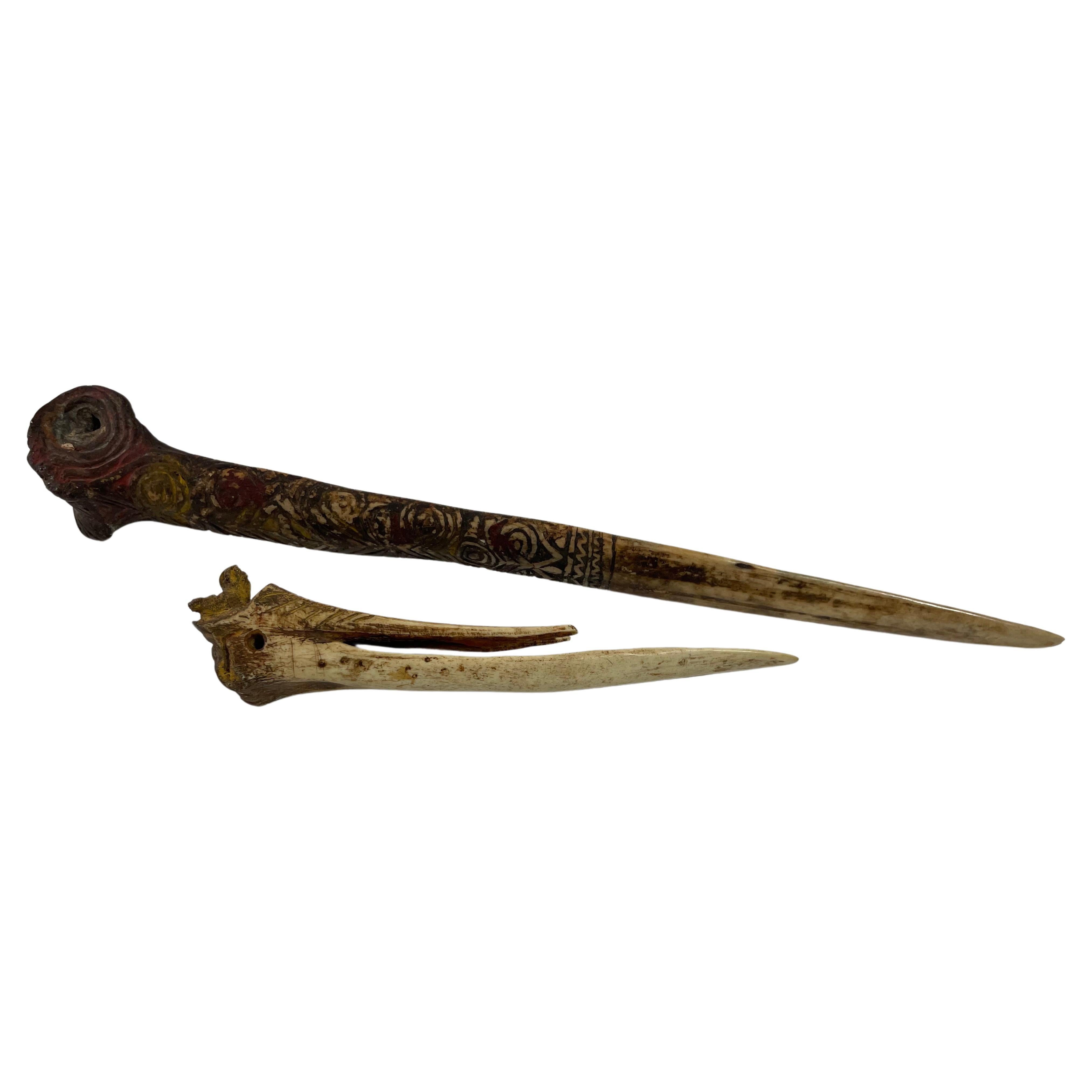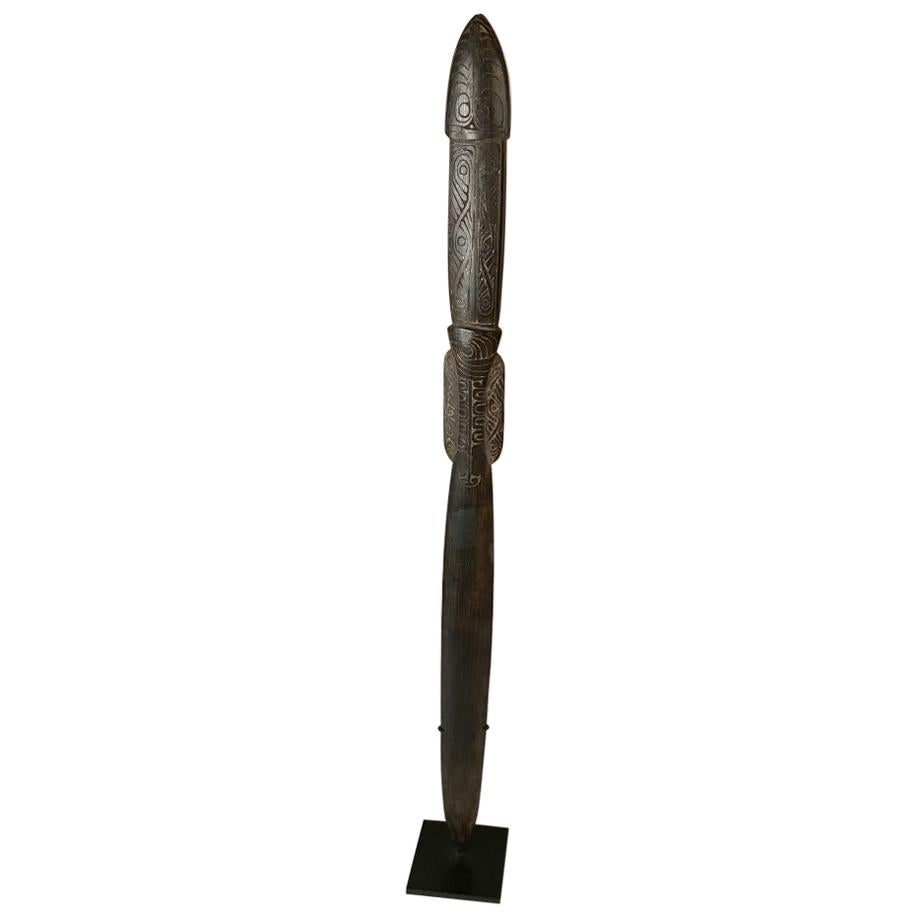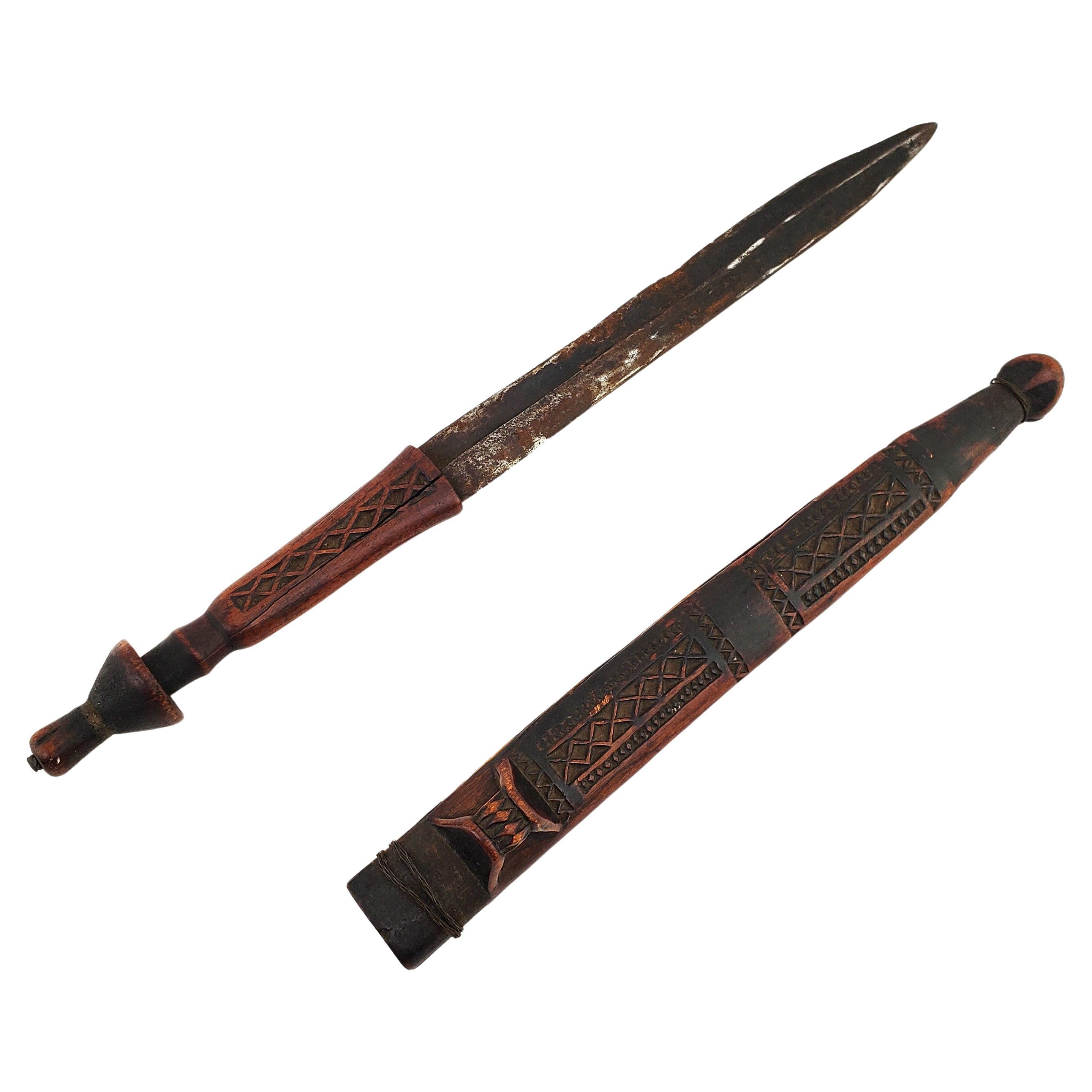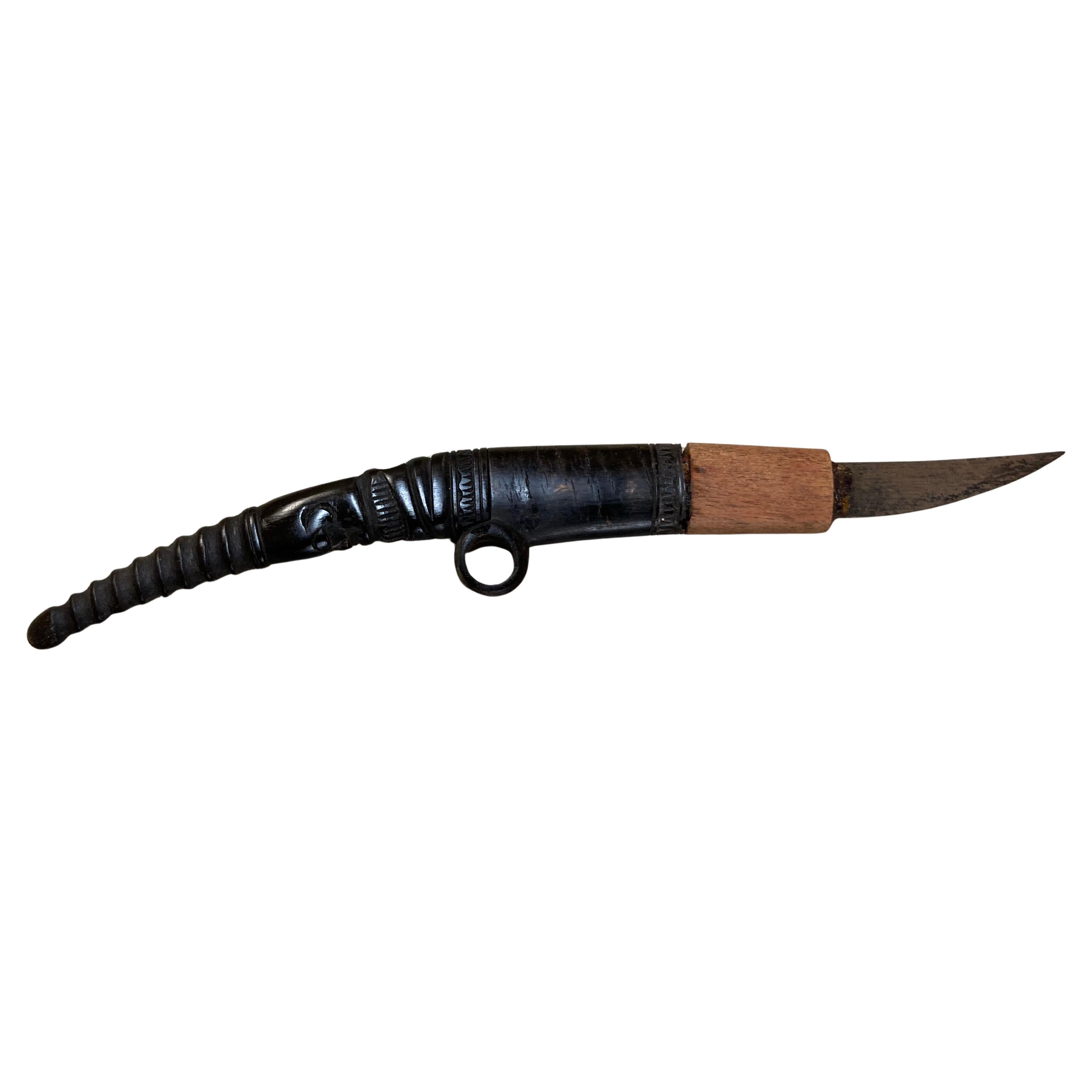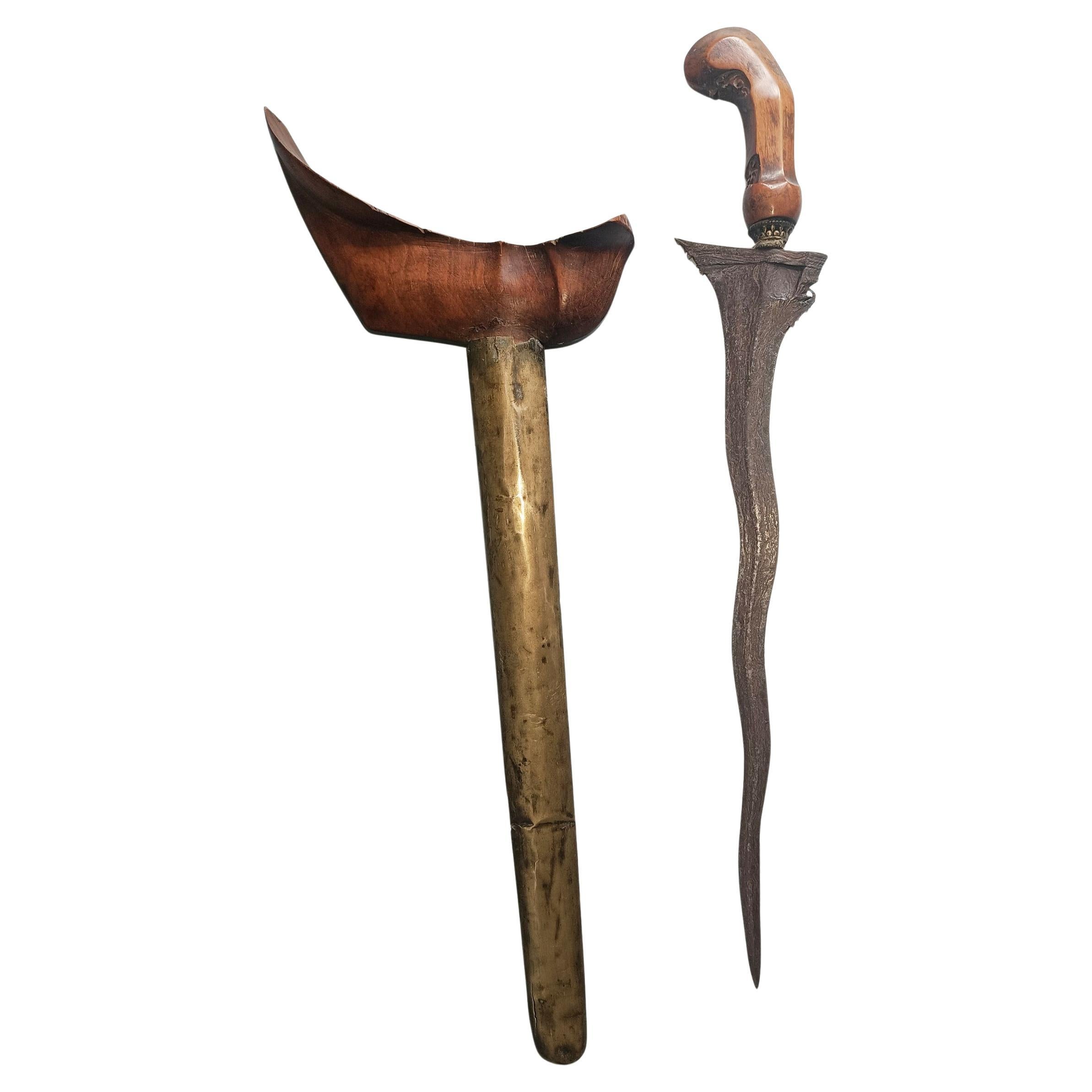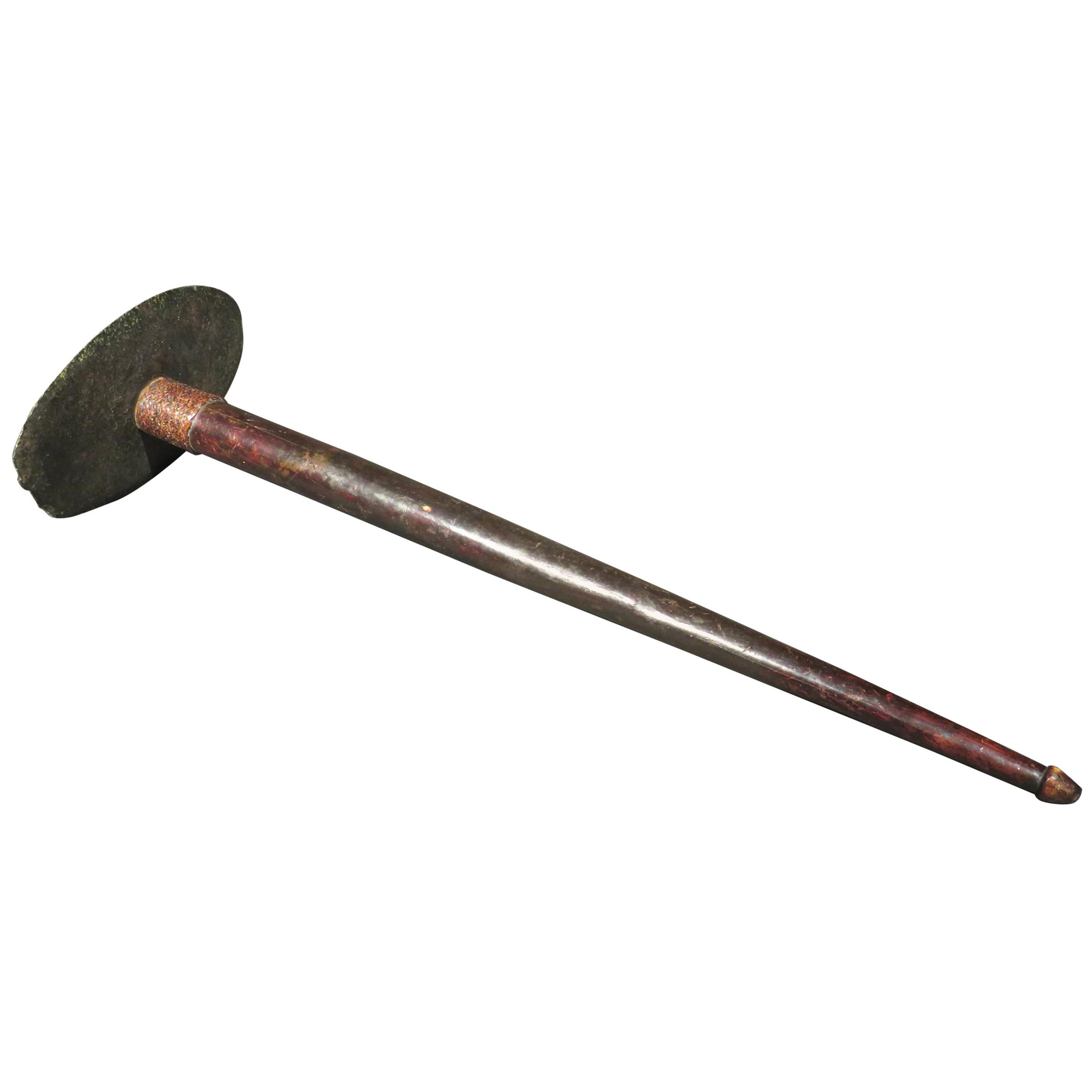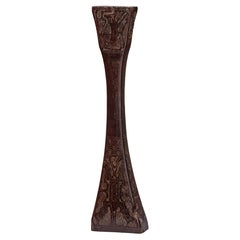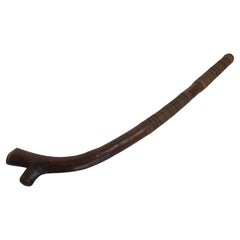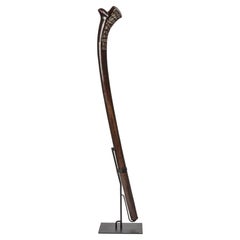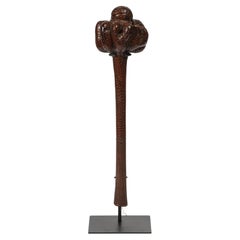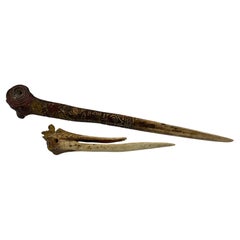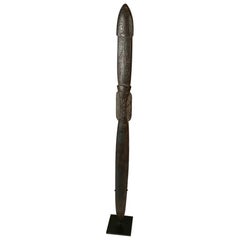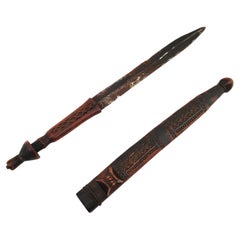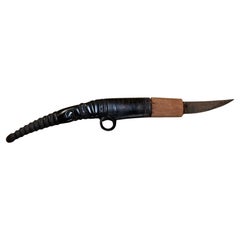Items Similar to An engraved Sepik cassowary bone dagger
Want more images or videos?
Request additional images or videos from the seller
1 of 3
An engraved Sepik cassowary bone dagger
$1,644.78
£1,217.95
€1,380
CA$2,261.82
A$2,515.72
CHF 1,316.68
MX$30,683.55
NOK 16,544.52
SEK 15,562.26
DKK 10,506.37
About the Item
Papua New Guinea, Sepik Region, Abelam people, early 20th century
Bone daggers in the Sepik region are traditionally crafted from the thigh bone of the cassowary bird (moruk in Tok Pisin), a large, flightless bird native to Papua New Guinea. These daggers, often adorned with intricate ancestor and clan designs, reflect the cultural and symbolic significance of the weapon. Warriors carried these multipurpose tools in a woven band on the upper arm or on a cord around the neck for use in close-quarters combat, hunting, digging, ceremonial sacrifices, and as decoration during singsing (dancing) events. The blunt-edged, sharp-tipped daggers were primarily used for stabbing, often delivering a final blow to an enemy incapacitated by spears or arrows or in stealthy assassinations.
Daggers were also considered powerful supernatural objects, playing key roles in male initiation and other ceremonies. They were worn as personal ornaments, and those with blunt tips likely served ceremonial purposes. When the tip became too damaged, the dagger was often repurposed into a lime spatula or thatch-sewing tool. Although cassowary leg bones were the primary material, in rare cases, daggers were made from the femurs of ancestors or enemies
Provenance:
Collection Rinck Hollnberger, Munich (purchased the 1990's)
- Dimensions:Height: 13.39 in (34 cm)Width: 1.58 in (4 cm)Depth: 1.97 in (5 cm)
- Materials and Techniques:Bone,Engraved
- Place of Origin:
- Period:
- Date of Manufacture:late 19th/early 20th century
- Condition:Wear consistent with age and use.
- Seller Location:Amsterdam, NL
- Reference Number:1stDibs: LU5458242061932
About the Seller
5.0
Recognized Seller
These prestigious sellers are industry leaders and represent the highest echelon for item quality and design.
Established in 1985
1stDibs seller since 2020
23 sales on 1stDibs
Typical response time: 5 hours
- ShippingRetrieving quote...Shipping from: Maastricht, Netherlands
- Return Policy
Authenticity Guarantee
In the unlikely event there’s an issue with an item’s authenticity, contact us within 1 year for a full refund. DetailsMoney-Back Guarantee
If your item is not as described, is damaged in transit, or does not arrive, contact us within 7 days for a full refund. Details24-Hour Cancellation
You have a 24-hour grace period in which to reconsider your purchase, with no questions asked.Vetted Professional Sellers
Our world-class sellers must adhere to strict standards for service and quality, maintaining the integrity of our listings.Price-Match Guarantee
If you find that a seller listed the same item for a lower price elsewhere, we’ll match it.Trusted Global Delivery
Our best-in-class carrier network provides specialized shipping options worldwide, including custom delivery.More From This Seller
View AllLarge Brazilian or Guyana Amazon Indigenous Macana War Club, 18th or Earlier
Located in Amsterdam, NL
A splendid and rare Amazon indigenous wamara wood Macana war-club
Southern-Guyana or Northern Brazil, Wapitxana group of the Aruak peoples, 18th century, possibly earlier
Measure: H. 43 cm
The deep patina of the club present, and the residue on the part where it was held, attest to its great age.
This unusually large Macana is decorated with several incised whitened anthropomorphic and human figures, a decoration only found on one other documented club in the British Museum, which is illustrated in: Hjalmar Stolpe, Amazon Indian...
Category
Antique Early 18th Century Brazilian Native American Objects
Materials
Hardwood
A Polynesian war-club or 'Gata waka'
Located in Amsterdam, NL
Fiji, probably early 20th century
Polynesian culture is traditionally a culture of power and prestige, and there was a fine line between battle and ceremony. Warrior people par exce...
Category
Early 20th Century Fijian Tribal Art
Materials
Hardwood
18th Century Polynesian Ironwood Gata Waka or War Club from Fiji
Located in Amsterdam, NL
A Polynesian ironwood Gata waka or war club
Fiji, probably 18th century or earlier
Measures: Height. 97 cm
Including museum-quality powder-coated stand.
Provenance:
Private collection, France
Polynesian culture is traditionally a culture of power and prestige, and there was a fine line between battle and ceremony. Warrior people par excellence, the Fijians had at their disposal a large panoply of weapons, each for a specific use.
The elegant Gata are called gun-sticks by Europeans due to the recognizable form. However, they are designed after a snake, gata in Fijian language. The Ula throwing clubs...
Category
Antique 18th Century Fijian Tribal Art
Materials
Hardwood
18th Century Polynesian Hardwood Ula Tavatava or Throwing War Club from Fiji
Located in Amsterdam, NL
A Polynesian hardwood Ula tavatava or throwing war club
Fiji, probably 18th century
All-over decorated in incised pattern, the bulbous top seems to have a stone grown into it.
H. 42 cm
Including museum-quality powder-coated stand.
Provenance:
Private collection, France
Polynesian culture is traditionally a culture of power and prestige, and there was a fine line between battle and ceremony. Warrior people par excellence, the Fijians had at their disposal a large panoply of weapons, each for a specific use.
The elegant Gata are called gun-sticks by Europeans due to the recognizable form. However, they are designed after a snake, gata in Fijian language. The Ula throwing clubs...
Category
Antique 18th Century Fijian Tribal Art
Materials
Hardwood
A rare Papua 'Gope' Spirit board from the Schulze Westrum collection
Located in Amsterdam, NL
A rare Papua 'Gope' Spirit board from the Schulze Westrum collection
New Guinea, Papua Gulf, probably Urama people, late 19th–early 20th century
H. 114 x W. 27 cm
Provenance:
- Co...
Category
Antique Late 19th Century Papua New Guinean Tribal Art
Materials
Wood
A Baimaru Kundu drum from the Schulze Westrum collection
Located in Amsterdam, NL
New Guinea, Papua Gulf, probably Baimaru people, late 19th–early 20th century
H. 81.5 x Diam. 15 cm.
Provenance:
- Collected by German biologist and cinematographer Thomas Schulze-...
Category
Early 20th Century Papua New Guinean Tribal Art
Materials
Animal Skin, Wood
You May Also Like
Antique Ethnic Artifact Sepik River Cassowary Bone from Papua New Guinea
Located in North Hollywood, CA
Antique Ethnic Artifact Sepik River Cassowary Bone from Papua New Guinea
For many groups in Papua New Guinea, bone was an important medium for making tools of all types. This artifact is made from leg bone of a cassowary, a large, flightless, and extremely dangerous, bird.
Cassowaries also play an important role in the mythology of groups in the Sepik River area.
Though no longer used these bone artifacts are still used ceremonially. They often play important roles in male initiation and other rituals. They are also worn as personal adornment by tucking them into a band of braided fibers worn around the upper arm.
Antique Ethnic Bone Cassowary Artifact with minimal carving and incised design confined to the joint end.
A small hole has been drilled through from both sides of the top and presumably for the threading of a cord.
The bone has been partially divided near the top and to form two prongs that project down the back of the dagger possibly allowing the user to wear is tuck into a waist band or belt.
Origin Papua New Guinea Maprik Dist Area
From the Art Collection of Marian and John Scott, acquired in 1962.
Similar items are in display in the Timothy S. Y. Lam Museum of Anthropology.
Purchased from the amazing private collection of Mark Lissauer who spent his life collecting niche ethnographic pieces.
About Mark Lissauer:
Mark Lissauer spent forty years travelling abroad for months at a time collecting ethnographic artefacts primarily from New Guinea and the islands of the West Pacific, and from Asia and Himalayan countries. Fluent in five languages and having in the course of business travelled to more than forty countries, Mark is well-known to museums and art-collectors around the world for his long career and his interesting and diverse collection of rare ethnographic material.
Mark knows the origin and symbolism of each piece. Through extensive research and more than ninety trips around the globe, Mark familiarised himself with the traditions of the various cultures he visited in order to understand the meaning of each object to its region and tribe. His home has a specialist library and several rooms are filled with tribal carvings, textiles and ethnographica.
He acquired his first tribal piece in 1948 during a business trip to Milne Bay, New Guinea, and has since documented the acquisition of some 35,000 items. Several thousands of these have been sold to important private collections and museums worldwide, including the Rockefeller Museum, the British Museum and the Musée National des Arts d’Afrique et d’Océanie, now incorporated into the Louvre Museum.
Estimator certificate of authenticity by Wayne Heathcote Tribal Art Dealer and Expert.
Heathcote has a flash gallery in Brussels, where much of the tribal art business is centred, and is an expert at Sotheby's tribal art sale...
Category
Early 20th Century Folk Art Tribal Art
Materials
Bone
Oceanic Carved Hardwood Lime Spatula, Papua New Guinea
Located in Stamford, CT
A Papua New Guinea hand carved ebony lime spatula covered with continuous swirl designs etched on the open handle and shaft, with some traces of lime stil...
Category
Mid-20th Century Indonesian Tribal Sculptures and Carvings
Materials
Ebony
19th Century African Shona Dagger
Located in Hamilton, Ontario
19th Century dagger from the Shona people of Zimbabwe. It features beautiful carvings, a rich aged patina and a handmade steeped blade.
Category
Antique 1890s Zimbabwean Arms, Armor and Weapons
Materials
Metal
Dayak Men’s Carved Horn Utility Knife
Located in Bridgeport, CT
A fine carved water Buffalo horn Men’s Utility knife in traditional form. Used for tasks within the extensive forest areas of the Dayak Tribes in Borneo, the knife has the original c...
Category
20th Century Tribal Tribal Art
Materials
Steel
Large Antique Indonesian Kris Dagger – Ethnographic collectible weapons
Located in London, GB
Large Antique Indonesian Kris Dagger – Ethnographic collectible weapons
A striking and authentic large antique Indonesian Kris (keris) dagger, dating to the early 20th century. This traditional Southeast Asian weapon features a dramatic curved zigzag (luk) blade, expertly forged and finely detailed, symbolizing power and spiritual energy. The blade is paired with a carved Horn hilt and shaped wooden sheath, showcasing classic Indonesian...
Category
Early 20th Century Indonesian Tribal Art
Materials
Wood
A Rare Papua New Guinea Kukukuku War Club, Eastern Highlands - Morobe Province
Located in Ottawa, Ontario
This rare antique Kukukuku (pronounced "cookah-cookah") war club originates from the Morobe Province, which is a very remote area located within the Eastern Highlands of Papua New Gu...
Category
Early 20th Century Papua New Guinean Tribal Arms, Armor and Weapons
Materials
Stone
